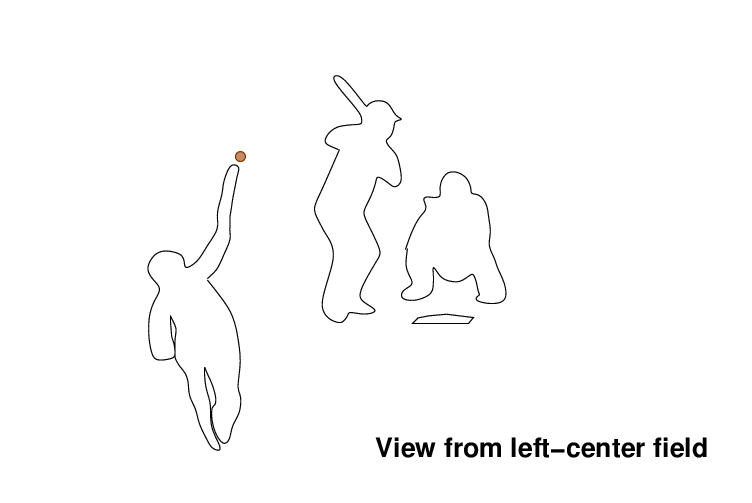
Why does a curveball curve? What's the difference between a cutter and a slider? The art of pitching is filled with arcane terms, and even when two players are talking about the same thing, they often use different words. In this series of articles, we're going to look carefully at the motion of a baseball through the air: how does it behave and what can a pitcher do to control it?
Today, we focus on arm angle: the position of a pitcher's arm as he releases the ball. You may have heard that a fastball thrown with a sidearm motion breaks in a different manner than one thrown over the top. We'll define that term, breaks, and introduce a diagram based on the size and direction of the break to help classify pitches.
We'll view the action from a seat in the outfield, just to the left of center; it's a common location for television cameras. The pitcher is just releasing a fastball:

To help describe both the pitcher's arm, and the spin of the ball, we superimpose the face of a clock on the mound, so that the pitcher stands on top of the six.
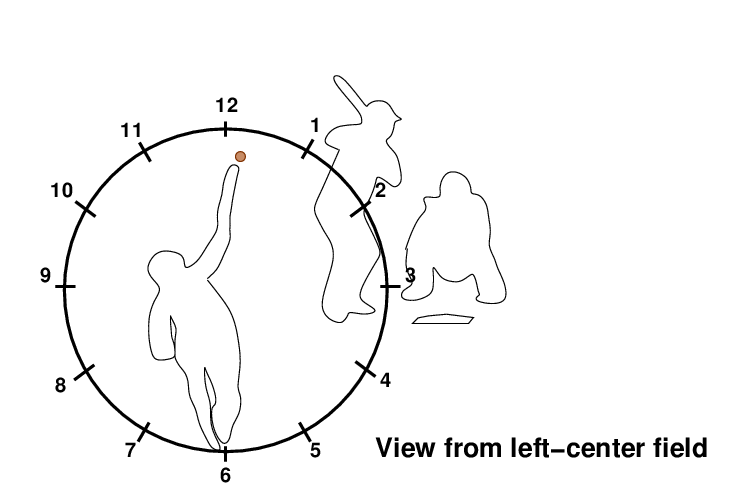
Since the arm points to the "12" on the clock as the ball is released, we could call this a "12 o'clock arm angle." The usual term for this position is "over the top."
In a basic fastball, the ball rolls along the fingers, picking up spin as it goes, and is finally released with pure backspin. Since the fingers are pointing vertically upward, the ball's spin has the same vertical orientation. Here's a closeup view of the ball, just as it comes out of the pitcher's hand:
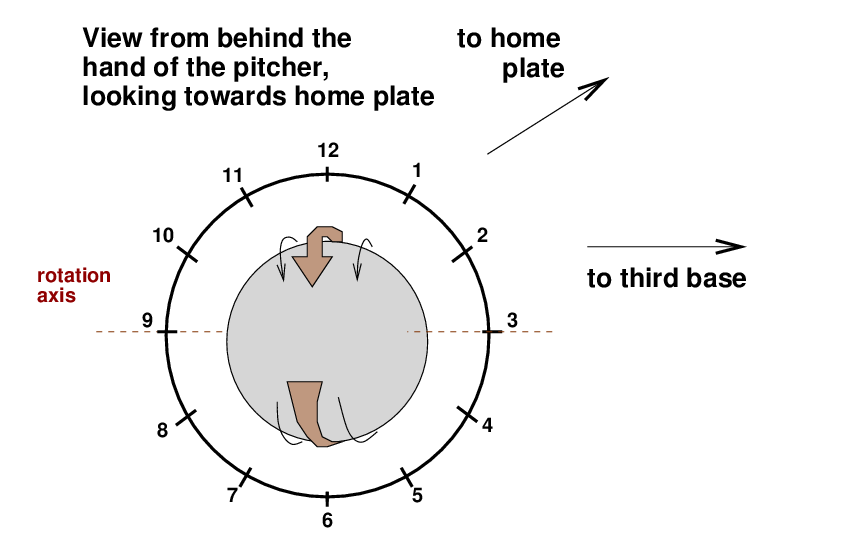
As you will recall from the first article in this series, the interaction between a spinning ball and the air flowing past it creates a force, the Magnus force. This force acts in the direction towards which the very front of the ball is spinning. In the diagram above, we see that the back of the ball is spinning down, which means that the front of the ball is spinning -- and the Magnus force is pushing -- up.
In other words, a "12 o'clock fastball" produced by an arm which points to the "12" on a clock face will experience a force pushing it up toward that same "12" on the clock face.
A very exaggerated cartoon of this pitch's trajectory looks something like this:
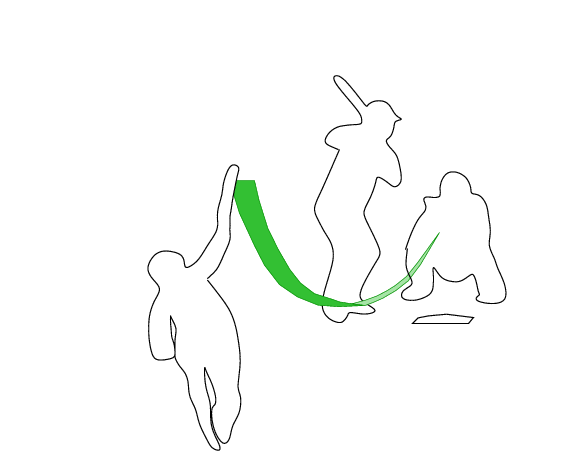
As explained in the basic fastball article, the spinning pitch does not actually rise during its motion. However, it does end up striking the catcher's mitt higher above the ground than a spinless ball thrown with the same initial velocity. If we make the definition
break: the difference between the final location of a spinning pitch and a spinless pitch with the same initial velocity
then we can say that this particular fastball "breaks straight up."
Not all pitchers hold their arms vertically above their shoulder as they release the ball. Many extend the arm to the side, so that it makes an angle roughly 45-degree from the vertical. The common term for this arm slot is three-quarters, but one could also call it a "one-thirty arm angle".
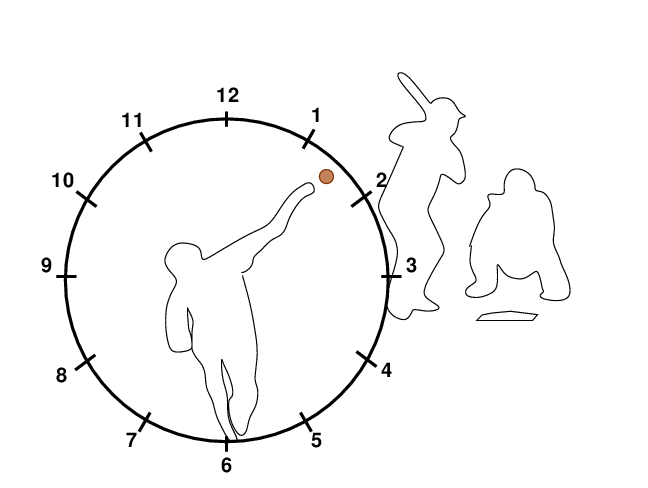
The fingers of a pitcher using this motion will also point to 1:30 on the clock, and the spin of a fastball rolling off those fingers will therefore be tilted in the same direction.
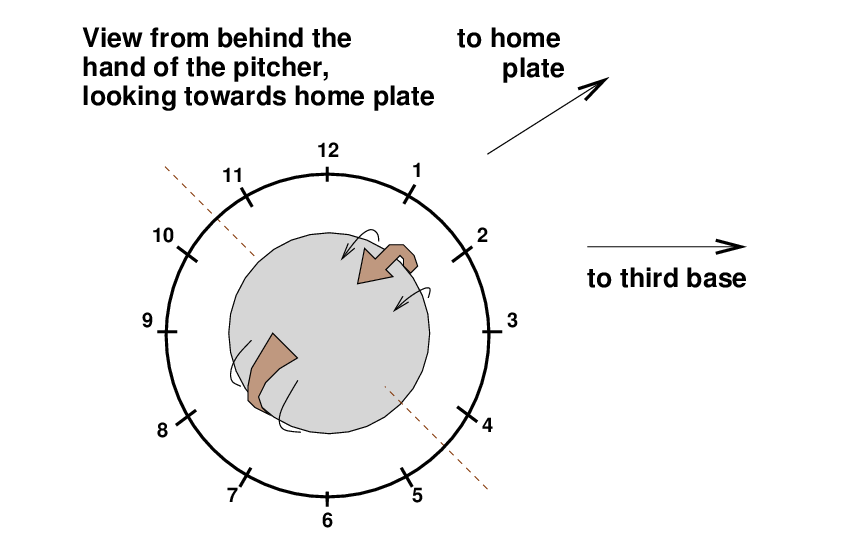
In this case, the Magnus force does not push the ball purely upward; instead, it deflects the ball both vertically up and horizontally toward third base.
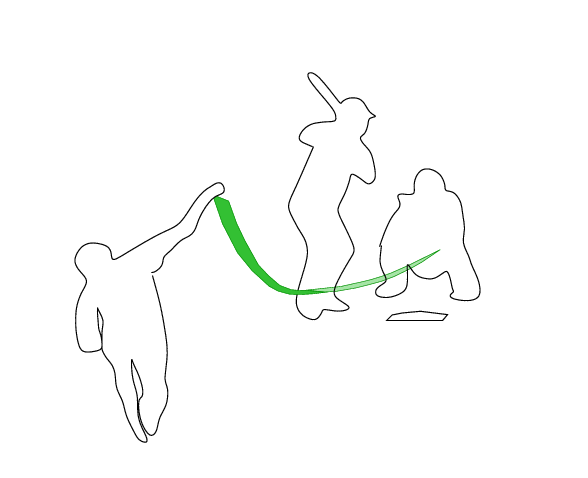
This pitch will break up by a small amount, and also break a small amount toward third base: away from a left-handed batter (as seen in the figure above), or in toward a right-handed batter.
If a pitcher "drops down" so that his arm is roughly horizontal, his arm and fingers will point toward third base as he releases the ball.
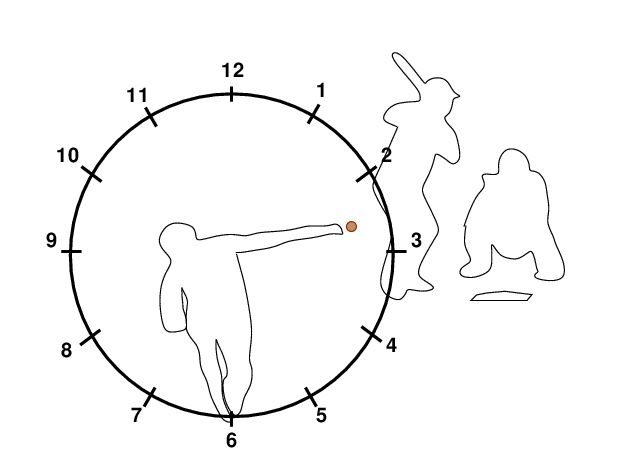
A fastball thrown from this arm angle will spin "on its side", so that the front of the ball rotates toward the "3" on a clock face.
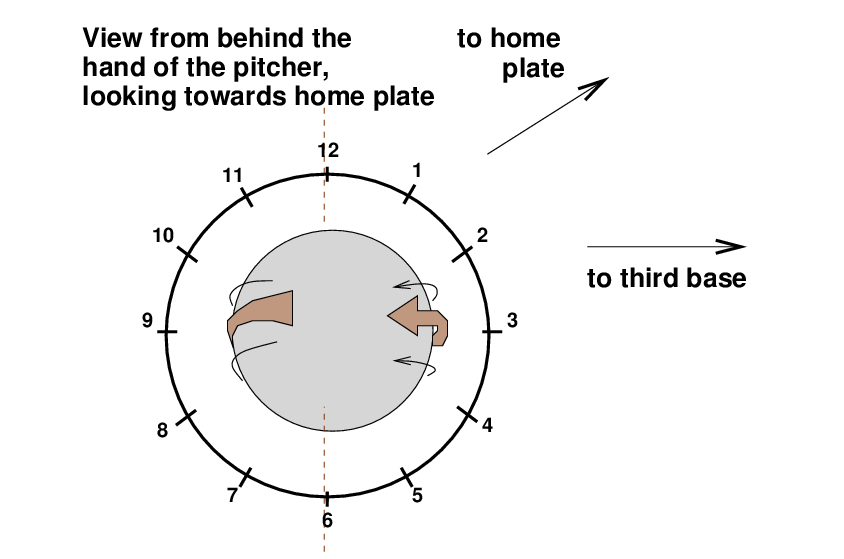
The Magnus force has no vertical component on this pitch; it pushes the ball purely horizontally toward third base. A sidearm fastball breaks away from left-handed batters, or toward right-handed batters.
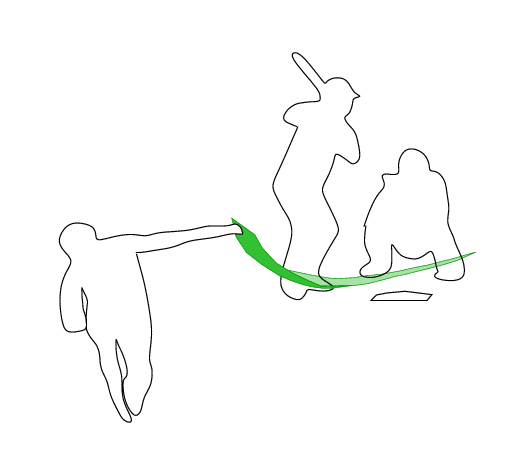
Now that we've defined what "break" means, we can use it as a tool to identify pitches; it will tell us something about the pitcher, too. Let's separate the break of a pitch into horizontal and vertical components, and use these to make a diagram. This isn't a new idea: people started making similar diagrams as soon as Pitchf/x [ed note: link to Pitchf/x] data became available.
In order to compare our results easily to those of other analysts, we'll switch the point of view: the diagram below shows the horizontal and vertical components of a pitch's break from the point of view of the umpire. Third base is now to the left, and first base to the right.
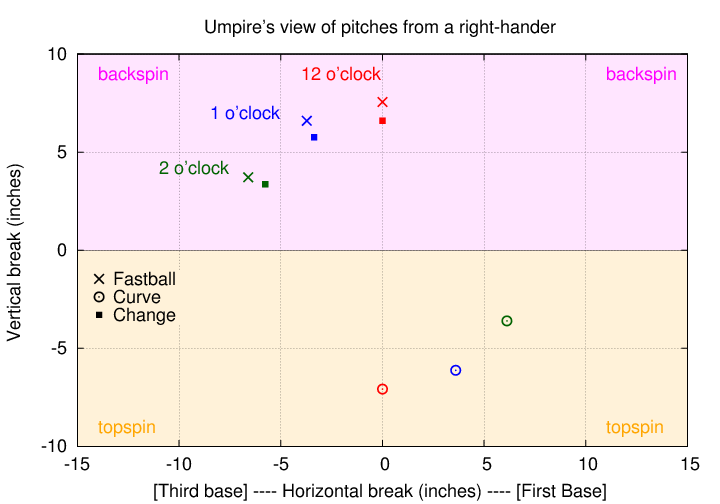
A pitcher who throws with an overhand motion --- so that his arm points to the "12 o'clock" position --- will give his fastballs and changeups pure backspin, so that the Magnus force pushes them straight up. His curveballs will have pure topspin, so that they break straight down. His pitches will appear in the locations shown by the red symbols on this diagram.
A pitcher who extends his arm slightly to the side --- so that his arm points to the "1 o'clock" position from the centerfield seats --- will impart a small tilt to the spin axis of his offerings. The resulting Magnus force will nudge his fastballs a bit toward third base, as well as lifting them vertically. His curveballs will drift a bit toward first base, in addition to diving down. The locus of his pitches (the blue symbols) will rotate slightly, so that it runs from upper-left to lower-right.
The lower a pitcher drops his arm, the greater this rotation in the break/break diagram. A right-handed sidearm pitcher throws fastballs that break toward third and curveballs that break sharply toward first. This is one reason that right-handed batters, in general, have trouble facing right-handed pitchers: the curveballs break away from them. A relief pitcher with particularly large horizontal movement (created in part by a low arm angle) can become a "specialist", brought into the game just to face one or two batters; hence the term "ROOGY" (Right-handed One Out GuY).
Of course, that raises the question, "What about the LOOGY"? Can lefties take advantage of their arm position, too?
Of course they can! Although some left-handed pitchers throw straight over the top (and so produce pitches which break straight up and down, just like their right-handed counterparts), most lefties extend their arms to the first-base side as they release the ball. Their arm angles end up somewhere between 12 o'clock and 9 o'clock.
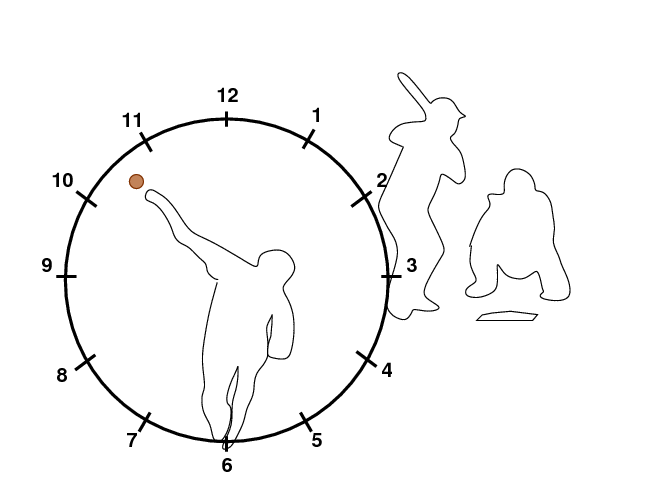
In the vertical vs. horizontal break diagram, the locus of a left-hander's pitches rotates in the other direction, so that it stretches from upper-right to lower-left.
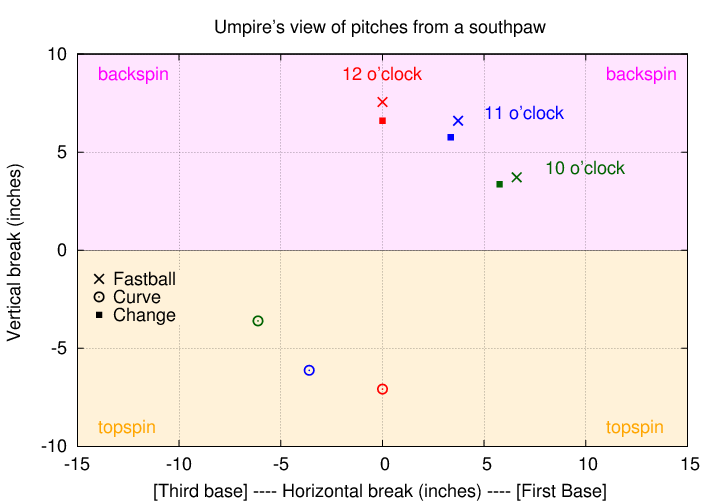
Let's see if this simple relationship between arm angle and pitch trajectory actually works in practice. We'll use the Pitchf/x [ed note: link] data from a single game for one righty and one lefty.
Our right-handed pitcher is Stephen Strasburg of the Washington Nationals. The picture below indicates that his arm is roughly 45 degrees away from vertical when he releases the ball.
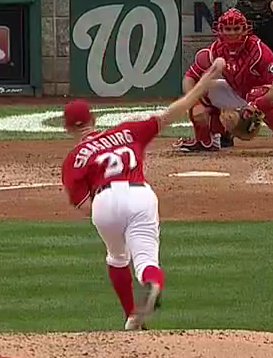
On July 7, 2014, [ed note: link to game log] the Nationals faced the Orioles in Washington. Strasburg pitched seven strong innings, striking out nine and giving up four hits. His repertoire was limited to just three pitches: fastball, change, and curve.
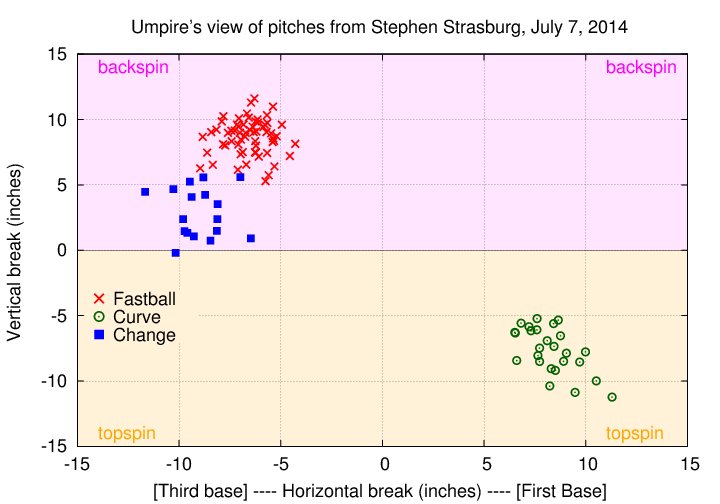
Voila! Almost exactly as theory predicts, the symbols run diagonally from upper-left to lower-right. The one difference is the location of the changeups: their horizontal break is a bit larger than that of the fastballs, not smaller. There are [ed note: link to changeup article] several ways to grip a changeup, [ed note: end link], and I guess that Strasburg's version tilts the spin axis slightly relative to his arm.
Our left-handed example is Jason Vargas of the Kansas City Royals. His arm is nearly vertical at the release, making him an "11 o'clock" pitcher.
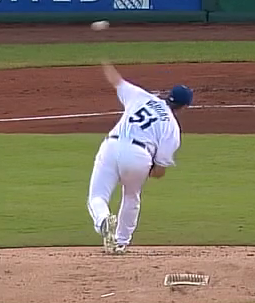
On August 13, 2014 [ed note: link to game log], he shut out the Oakland A's on three hits and no walks. Like Strasburg, he relied on just three pitches.
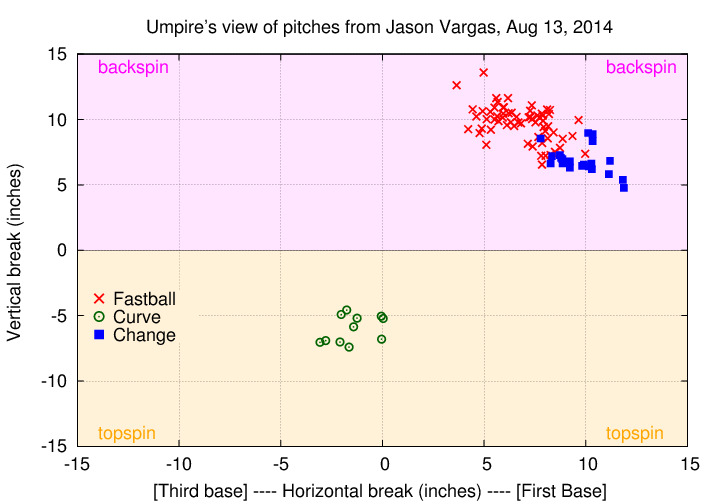
Again, we see the expected pattern: a diagonal swath of symbols, running this time from upper-right to lower-left. Just as Vargas's arm is more nearly vertical than Strasburg's, the overall pattern of his pitches is more nearly vertical. The fact that the changeups again have a greater horizontal break than the fastballs suggests that Vargas and Strasburg have a similar technique for gripping their changeups.
The direction a pitcher's arm has a very strong effect on the behavior of his pitches, both in theory and in practice. Watch carefully, and you'll see that many of the late-inning ROOGYs and LOOGYs use extreme arm angles to make their off-speed pitches run away from from their victims. You'll also see the vertical- versus horizontal-break diagram which so neatly encapsulates these effects in many sabremetric discussions, and in future installments of this series.